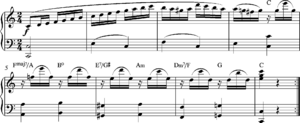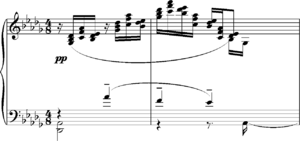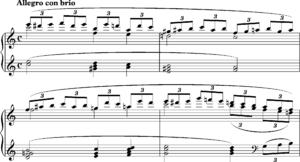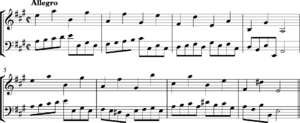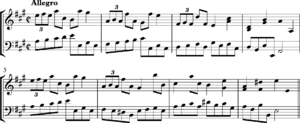Variation (music) facts for kids
In music, a variation is a cool way to repeat a musical idea, but with changes! Imagine you have a simple tune, and you play it again, but this time you make it sound different. You can change the melody (the main tune), the rhythm (how fast or slow the notes are), the harmony (the chords that go with the tune), or even the instruments playing it. Composers use variations to keep music interesting and exciting.
Contents
How Musicians Create Variations
Let's look at some ways composers change a musical idea. Mozart's famous "Twinkle, Twinkle, Little Star" (which he called "Twelve Variations on 'Ah vous dirai-je, Maman'") is a perfect example. Here's the original tune:
Changing the Melody
In his first variation, Mozart adds extra notes and fancy twists to the simple tune. It's like decorating a plain line with swirls and dots.
Changing the Rhythm
The fifth variation makes the music feel different by changing the rhythm. Instead of a steady beat, it uses syncopated (off-beat) rhythms, making it sound more playful and bouncy.
Changing the Chords
In the seventh variation, Mozart introduces new, strong chords. These new harmonies give the original tune a different feeling, making it sound richer and more dramatic.
Changing to a Minor Key
The eighth variation is quite clever! Mozart switches the music from a happy-sounding major key to a more serious or sad-sounding minor key. He also mixes in other techniques like counterpoint (two or more melodies playing at once) and imitation (one part copying another).
You can hear a full performance of this piece online to hear all the variations!
Other Cool Examples
Variations aren't just found in pieces called "Theme and Variations." Composers often use them inside other musical works too.
- When a tune comes back in Chopin's Nocturne in F minor, he repeats it with elegant melodic changes. It's like hearing the same idea, but dressed up differently.

- Debussy's "Reflets dans l'Eau" (meaning "Reflections in the Water") starts with a sequence of chords. Later, when these chords return, they are played as arpeggios (broken chords), making them sound shimmering, like water.
- Sometimes, the original tune and its variation are played at the same time! In Beethoven's "Waldstein" sonata, one hand plays the main tune, while the other hand plays a decorated version of it.
- Not all variations make the music more complex. In 1819, Anton Diabelli asked composers to write variations on a waltz he wrote. Beethoven created 33 variations! One of them, Variation No. 13, actually makes the music simpler, almost like reducing it to its basic parts.
- Similarly, the first variation in Rachmaninoff’s Rhapsody on a Theme of Paganini is a very short and quick summary of the original tune.
Variations on Other Composers' Music
Many composers love to take a piece written by someone else and create their own variations on it.
- For example, Arcangelo Corelli wrote a simple violin tune in 1700. His student, Francesco Geminiani, later made a "playing version" of it, adding many more notes and making it sound like a completely new, catchy tune.
- In jazz music, musicians often create variations on popular songs. Gil Evans' arrangement of George Gershwin's "Summertime" is a great example. He changes the instruments and sounds, creating a rich background for Miles Davis to improvise his own variations on the melody.
What is Variation Form?
"Variation form" is a way of structuring a whole piece of music. It usually starts with a main theme (a tune or musical idea), and then that theme is repeated several times, but each time it's changed or varied.
- Some variation forms, like ground bass, passacaglia, and chaconne, are based on a short, repeating musical idea, often in the bass (low notes).
- "Theme and variations" pieces focus on changing the main melody. The theme is usually 8 to 32 measures long, and each variation often keeps the same length and structure as the original theme.
This form might have started because old court dances were long, but their tunes were short. To keep things interesting, musicians would improvise variations while keeping the dance's timing.
Variation pieces can be stand-alone works for one instrument or a group, or they can be a movement (a section) within a larger piece like a symphony. Most jazz music is also built on this idea of theme and variations.
Famous examples include Bach's Goldberg Variations, Beethoven's Diabelli Variations, and Elgar's Enigma Variations.
A Brief History of Variations
The idea of musical variations has been around for a long time!
- Early Days: The first examples appeared in the 14th century, but pieces fully in "theme and variation" form started showing up in the early 1500s. A common type back then was "divisions," where the main beat was divided into smaller and smaller notes, making the music more intricate.
- Baroque Era (1600-1750): Composers like George Frideric Handel and Johann Sebastian Bach wrote famous variation sets for harpsichord.
- Classical Era (1750-1820): Wolfgang Amadeus Mozart and Joseph Haydn wrote many variations. Haydn was known for "double variations," where he'd vary two related themes, often one in a major key and one in a minor key. Ludwig van Beethoven also wrote many important variation sets, both as stand-alone pieces and as parts of his larger works like symphonies and sonatas.
- Romantic Era (1820-1910): Composers like Frédéric Chopin and Johannes Brahms continued to develop the variation form. Brahms's Variations on a Theme by Haydn is famous for being one of the first orchestral variation pieces that was a complete work on its own.
- 20th Century and Beyond: Variations are still popular today! Composers like Sergei Rachmaninoff, Igor Stravinsky, and Benjamin Britten have written well-known variation pieces. Some modern composers even write variations on popular songs or create pieces where different composers each write one variation.
Making Up Variations on the Spot
Skilled musicians can often improvise (make up on the spot) variations on a theme. This was very common in the Baroque era. Singers in operas were expected to improvise fancy variations when a main tune returned. Composers like Corelli would sometimes only write the basic notes, and the performer would add all the beautiful decorations and variations.
In the Classical era, both Mozart and Beethoven were famous for their amazing improvised variations during concerts.
Today, improvising variations on a popular tune is a core part of jazz music. Jazz musicians often start with a well-known song and then create their own unique versions, changing the melody, rhythm, and harmony as they play. Famous jazz musicians like Charlie Parker and Coleman Hawkins were masters of this, creating incredible new music from existing tunes.
This idea of spontaneous variation is also a big part of traditional African music, where musicians add their own twists and changes to melodies and rhythms as they perform.
See also
 In Spanish: Variación (música) para niños
In Spanish: Variación (música) para niños
- Composer tributes (classical music)
- Developing variation
- Inversion
- Matrix (music)
- Strophic form
- Traditional sub-Saharan African harmony
- Tune-family



